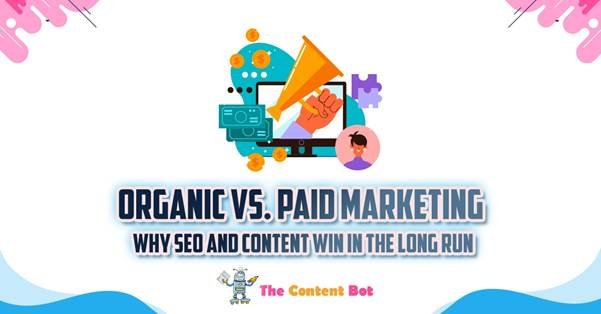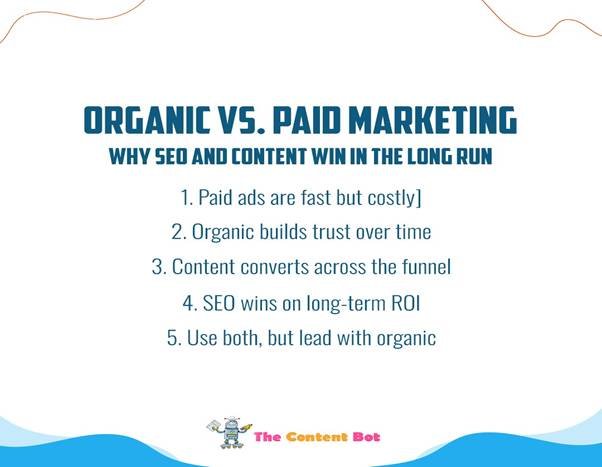
Organic vs Paid Marketing : All marketers are at the same decision point: do you spend on quick victories with paid advertising, or take the organic path and create authority through SEO and content? While instant visibility comes from paid ads, organic marketing is where long-term ROI really builds up. This blog breaks down the advantages and disadvantages of both, why SEO-driven content remains the most affordable growth lever and demonstrates how to align your marketing plan for long-term lead generation.
1. Paid ads are fast but costly]
Paid ads do work at least short-term. You get immediate clicks, traffic, and visibility. But here’s the rub: as soon as you cut out the checks, visibility vanishes. It’s rented space, not owned media. And in competitive spaces, CPCs are always going up.
Worse, most ad clicks don’t convert because the intent might not align with what you’re providing. It’s a high-cost loop of spending to remain visible.
Key Insight: Paid advertisements can be effective for campaigns but they don’t create long-term value or trust.
2. Organic builds trust over time
Organic marketing by SEO, blog posts, and inbound methods delivers more slowly, but with deeper and lasting impact. You’re building assets that exist on your website, rank in search engines, and keep generating traffic and leads throughout the years.
Organic content compounds in value. The more you write about core subject areas, the more authority you build, and the less you’ll need to rely on outside ad budgets.
Key Insight: SEO and content marketing enable you to own your visibility rather than rent it.

3. Content converts across the funnel
Excellent organic content doesn’t merely drive traffic it informs, nurtures, and converts. A solidly written blog post can get your solution in front of people, a case study creates credibility, and an SEO-optimized landing page seals the deal.
This full-funnel strategy is taking the buyer journey organically, with trust-driving touchpoints. Paid advertising is generally only targeting top or bottom funnel, breaking the customer experience.
Key Insight: Organic content can be optimized for every stage of the buyer paid advertising generally can’t.
4. SEO wins on long-term ROI
The initial investment in SEO and content marketing might feel steep but it pays off consistently. Once a blog ranks, it can deliver leads for years. That’s ROI no ad platform can match. Even when you stop investing, your content still works for you.
In contrast, the ROI of paid ads sharply declines once the campaign ends. That means you’re always spending to stay visible, with no cumulative value.
Key Insight: SEO is a compounding asset ads are an ongoing cost.
5. Use both, but lead with organic
There’s room for both organic and paid approaches. Ads might be used to test messaging or promote urgent campaigns. But for sustained stability, steady leads, and brand trust, SEO needs to be the foundation.
Paid advertising scales reach. Organic marketing establishes relationships. In today’s buyer-driven environment, the latter is the way trust and conversions are achieved.
Key Insight: Let paid ads fuel your growth, but construct your house on organic soil.
How The Content Bot Can Help
We don’t simply write content at The Content Bot we assist you in establishing a long-term, lead-generating system based on organic visibility. Our aim is to get your SEO working smarter and your content working harder, so you never have to depend on paid ads for good. Here’s what we have to offer:
- Data-driven SEO strategies that align with your audience and intent
- Conversion-focused blog and website content that ranks and converts
- Topic cluster and content mapping to establish topical authority
- On-page and technical SEO optimization for performance and visibility
- Growth tracking and content iteration so each piece does its part
We enable you to drive quality leads without pursuing clicks by ensuring your organic presence sells.
Frequently Asked Questions
Is organic marketing cheaper than ads?
Yes. Although it takes initial work, organic content is a permanent asset, whereas paid ads cease to function as soon as you halt spend.
How long does SEO take to work?
You can see early results in 3–6 months, with more robust growth in the long term as your content gains authority and visibility.
Can paid ads and SEO complement each other?
Absolutely. Use paid advertising for short-term gains or promotion, and have organic content form the foundation of your long-term strategy.
What type of content generates the most ROI?
Content that attracts high-intent keywords, addresses real problems, and leads users through your funnel works best.
Real-Life Examples
- A fast-growing SaaS company was relying heavily on Google Ads, spending nearly $10,000/month. They saw spikes in traffic but poor lead quality and low retention. After partnering with an SEO team, they pivoted to a content-driven strategy focused on high-intent search terms and educational resources for their audience. Within 8 months, their organic traffic doubled, ad spend was reduced by 50%, and their inbound leads were 3x more likely to convert.
- A niche consulting B2B startup was having trouble getting the right traffic. We assisted them in finding a high-intent, low-competition keyword that their prospects were looking for. The blog post that was written as a result was strategically written and SEO optimised. It now sits on page one, attracts more than 300 qualified visitors every month, and continuously generates demo signups with a 7% conversion rate something most landing pages can only dream of.
- A design agency was investing in LinkedIn and Facebook Ads for lead generation, but increasing costs made it impossible to sustain. When they suspended the campaigns, leads fell to zero. We collaborated with them to develop a sustained SEO and content plan for targeting decision-makers. Within fewer than six months, organic traffic increased consistently, and inbound leads became their main acquisition channel with no incremental ad budget.
Final thoughts
Paid advertising might make you noticed but not remembered. Organic marketing creates a reputation, not just awareness. In 2025, SEO and content are traffic tools no more they’re trust engines, sales enablers, and brand builders.
If your marketing budget is perpetually bleeding into ad platforms, it’s time to put your money towards something that pays dividends long after the campaign is over. Create content that works while you sleep, ranks for what your audience is already looking, and converts without the cost-per-click.
Organic marketing isn’t just a growth channel it’s the framework for sustainable, scalable success.

